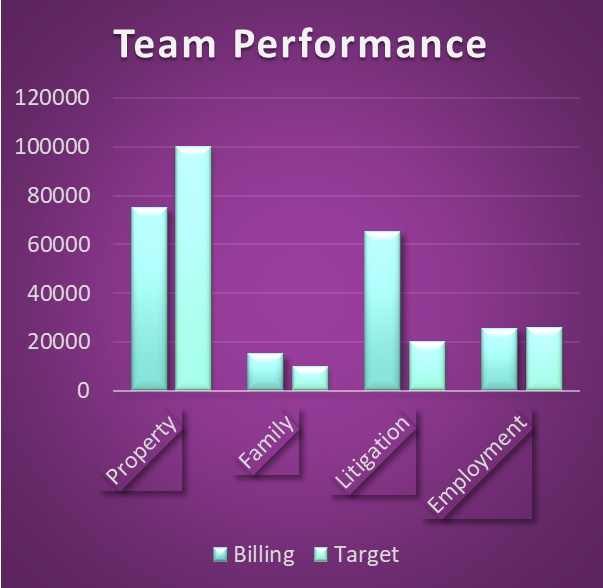 Katchr’s Graham Moore has been working with law firms for over 30 years and has worked with hundreds of small and medium sized firms, helping them improve their businesses with technology.
Katchr’s Graham Moore has been working with law firms for over 30 years and has worked with hundreds of small and medium sized firms, helping them improve their businesses with technology.
In this exclusive guest blog Graham shares some observations about the management information best practices that he sees in the most successful law firms.
There are three key practices that we see time and time again, in law firms that operate as successful businesses. They use information that:
- Is Future Focussed
- Drives Action
- Is Shared
Future Focussed
The first of these practices is to ensure that measurements are future focussed. Is your management information all about what happened last month? Did you spend your last partners or board meeting looking at reports like this:
And was the information all about a period that closed 5 days, or maybe 2 weeks earlier?
We can’t change the past. Top performing organisations focus on what they can change, what they can influence, and that is the future. This sounds like common sense, but so much standard law firm management information is backward looking.
The best performing firms focus on the future, and three key things they do are:
- Daily updates
- Focus on Inputs not Outputs
- Include measures that are predictive not just retrospective
The best performing firms have up to date management information available daily. They don’t need to pour over last months results 2 weeks later, because they know on the day the month closed how they have done. But more importantly, when they sit down to review performance of the firm, they are not focussed on last month. What can they do about that? They are focussed on what is likely to happen this month, and next month and how they can make decisions now to influence that.
Focussing on outputs is backward looking. What has happened? What have we produced What bills have we raised? How many new clients have we signed?
Focussing on inputs enables us to be more future focussed because it gives us an indication of future outputs:
- Are our fee earners busy on chargeable work? (Utilisation)
- Are we confidently billing all the time we record? (Realisation)
If so, our billing output will take care of itself.
And top performing firms are making use of predictive measures: so many law firm management report packs contain nothing but a detailed analysis of everything that happened last month. Why? Because measuring financial history is easy. You have the data, it might not look pretty but it tells you where we are.
However, does it help with where you are going? Managing a law firm, or any business, by purely looking at historical results is like driving a car whilst looking in the rear view mirror.
These are some examples of predictive measures that progressive and successful law firms are using
- Net promoter
- Conversion rate
- Client referrals
- Case turnaround time
- SLA achievement
- 360 degree feedback scores
- Staff referrals
See our handy guide to the “Top 25 KPIs that law firms don’t measure (but should)” for more detail on these and many more key measures for your firm.
Drive Action
Surely the whole point of measuring anything is to cause action. Data is meaningless unless it helps make decisions that have measurable impact. The best performing firms use data to Drive Action, and three key things they do are:
- Deliver information, not data
- Use clear visualisations
- Focus on exceptions
Context is what makes data useful. A billing value of £40,000 is useless as data, until you know whether that is for a single individual, or an entire firm, whether it is for a single day, for a month or for a year.
But equally importantly, to make it actionable we need to know expectations. Do we expect Jane’s billing to be 40k so far this year? Is that above or below target? How does she compare with the rest of her team? How does her billing compare with this time last year? Context turns data into information.
I know this is a generalisation, but most lawyers at the age of 18 or 21 made a choice to join the legal profession because their primary aptitude was words not numbers, so on that basis which of these presentations is most likely to engage and resonate with most of the lawyers in your firm?
The one on the right is great for your accountant. But many years of experience, and countless conversations with our best clients tells me that this is not best for lawyers. Style of visualisation is important.
Exception reporting is a key part of creating actionable information. What are exceptions?
Exceptions are the problems hidden in your data, they are the clues to what’s going wrong and risks you are exposed to. Exception reporting is often a case of running off a report and then sorting, filtering, or worse, manually scanning for issues. The best performing law firms automate exception reporting. They define the rules and then let the systems do what they are good at – scanning huge volumes of data very quickly to produce actionable output.
Share Information
Top Performing law firms focus on the future, not the past, they create actionable information, and then what do they do with it? They share the information, and devolve responsibility for the actions.
Back to the list of exceptions we looked at above, if there are 25 high risk cases with no fee estimate how do you resolve that? In top performing firms, responsibility is devolved to team leaders and then to the individual matter owners. If minimising risk is made every individual’s responsibility, and individuals are given the right information about where risk occurs, and team leaders are expected to monitor their direct reports, then the firm as a whole works together to resolve the issues. To make this happen, appropriate information is made quickly and easily available to all individuals with a stake in the resolution. That applies equally to financial performance as it does to risk management.
These are the three building blocks to get great results, improving performance by making better use of your data:
- Focus in the future
- Use data to drive action
- Share information
Katchr specialises in law firm business intelligence software, transforming law firm data into an invaluable decision‐making tool, to help drive growth in firms of all sizes.
Katchr law firm dashboards provide fast, easy access to KPIs and management information, giving clear, precise information at the touch of a button, enabling everyone in the firm to confidently make the best decisions.












